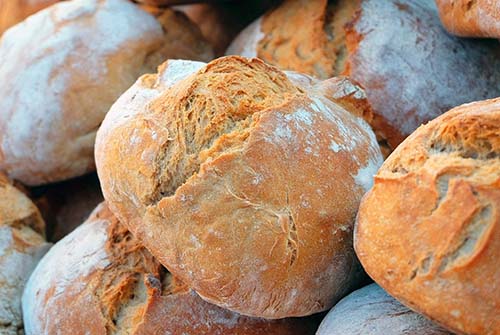You don’t need to be a professional baker or even a culinary student to know that the dusty old bag of flour lurking in the back of your pantry might not be the best option when you’re in the mood to whip up a fresh, crusty loaf of bread.
Even in a conventional grocery store, you have many options to choose from when it comes to different flours: those that are indicated for different purposes, white and whole wheat, and even those made with alternative grains.
So which is or are the best option(s) when it comes to making bread? Is bread flour the only way to go?
In order to choose the best flour (or flours) specifically for bread-baking, it’s important to understand the basic science at the heart of the process that produces a successful, crusty loaf.
“In order to produce a great loaf of bread, one needs to have the proper structure that comes from the high quantity of protein that is found in what we consider bread flour or high-gluten flour,” says Stephen Chavez, Chef-Instructor at ICE LA.
“The gluten structure [in your bread dough] captures the carbon dioxide, part of the fermentation process that gives the bread rise,” says Jürgen David, ICE's Director of Pastry Research and Development.
The protein content of the flour that you choose, then, as well as the kneading process you apply to the dough, determines the gluten development and ultimately governs the outcome of your loaf. So in short, it matters greatly what flour you choose for bread baking.

What Differentiates Bread Flour from Other Types of Flour?
The difference between bread flour and other types of flour “comes down to the protein content of the flour,” says Chef Jürgen.
Most crusty bread recipes require flour with a high protein content.
“For recipes like cookie dough or cake batters, the protein content should be low so the texture remains tender,” he says.
The protein content varies considerably with different types of flour. Chef Jürgen breaks down the different percentages of protein found in different, commercially available wheat flours.
“Generally, bread flour contains about 15% protein, and all-purpose flour has between 10.5% and 11.5% protein, sometimes up to 13%,” he says. “Pastry flour has between 8.5% to 9.5% protein, and cake flour has only 7%.”
Chef Stephen adds: “You can also describe flours by their content of protein versus the content of starch contained in the flour. Protein is needed for structure. Starch is needed for tender texture through gelatinization,” he says. “Comparing the four most common types of commercial flour, bread flour is high in protein and low in starch. All-purpose flour contains close to equal amounts of protein and starch. Pastry flour has medium-high protein and high starch, and cake flour is low in protein, high in starch.”
Can You Use All-Purpose Flour for Bread Baking?
True to its name, all-purpose flour was developed to be a one-size-fits-all flour to be used in a number of ways.
“All-purpose flour was designed for home cooks to be able to use one flour in order to make a loaf of bread, or a cake or cookies,” Chef Stephen says. “However, as professionals, we can use specialized flours for specific applications that will work better than using a generic all-purpose flour.”
Second to bread flour, all-purpose flour does have the next highest amount of protein available, however. While bread flour is the best option, it can sometimes be used if you don’t have bread flour.
“Check the protein content,” advises Chef Jürgen, since it can vary from brand to brand, and an all-purpose flour that contains protein on the higher end of the range, 12 to 13 percent, will produce a better outcome.
AP flour can also be successful in certain types of recipes.
“AP flour can be used in the making of rich or enriched breads such as soft rolls, or brioche,” says Chef Stephen, which are meant to be softer in nature, rather than crusty.
Enriched breads typically include added fat in the dough in the form of butter, milk, oil, etc.
“AP flour does not work well for lean doughs such as those used for baguettes or other artisan breads,” he says.
Different Types of Flours for Different Types of Bread
It’s also important to consider that different types of bread can also call for different types of flour.
“Sometimes we mix types of flour in one recipe to balance the protein content,” says Chef Jürgen.
Not all bread recipes have the same intended outcome as well.
“Think of pizza dough where you need a very high percentage of gluten protein in order to take a small piece of dough and stretch it out to a large pizza size,” says Chef Stephen. “The dough will need to be soft but have a crispy finish, as opposed to a rich dough such as Hawaiian rolls which are very soft, or biscuits which should end up tender and flaky,” he says. “Each example should use a different type of flour in order to get the optimal results.”
Always try to utilize the correct flour that’s called for in whatever recipe you’re making.
What About Whole Wheat Flour?
Whole wheat flour, which is different from conventional flour which is also made from wheat, also has different considerations than bread flour when it comes to bread baking.
“Whole wheat flour contains both the bran and germ, which are removed by sifting for flour that is not whole wheat,” says Chef Jürgen. “The endosperm is the starch, and main part of the wheat kernel which is used in most flour.”
Whole wheat breads also typically contain at least some white flour in addition to whole wheat.
“Whole wheat flour can be incorporated into most breads effectively,” says Chef Stephen, which also brings additional nutrient value to breads. “However, it is best used in percentages below 70%,” he says. “Any amount of whole wheat above that would require a re-formulation of the recipe that would necessitate a higher percentage of water, or else your bread will turn out very heavy and dense. 100% whole wheat bread usually incorporates well over 100% water in order to come out light and fluffy.”
Are Alternative Flours Good For Bread Baking?
Alternative flours such as spelt, rye, and others can also be used for bread baking.
“They are delicious, nutrient rich and add a different flavor profile and texture,” says Chef Jürgen, but also come with additional considerations.
“Flour can be made from any grain, nut, seed, or tuber if it is ground enough until a powdery substance forms,” says Chef Stephen, “however, wheat flour must be used to make the type of bread found in Western civilization. Wheat flour is unique in that it is the only flour that has a large amount of gluten which is important for structure and texture in baking bread.”
Spelt is a form of wheat flour, and rye is a grain flour that also contains protein, but they too must also include white flour for a successful outcome, as they are low in gluten.
“Spelt and rye flours are both wonderful for use in bread, but as with whole wheat flour above, they must be used in moderation,” says Chef Stephen, along with a percentage of white flour.







